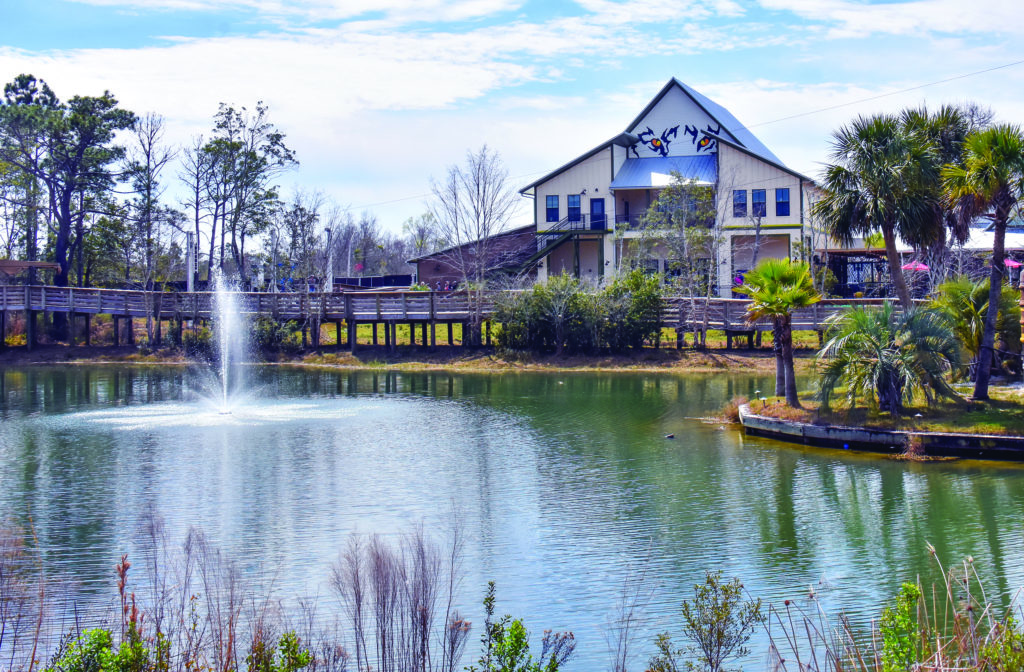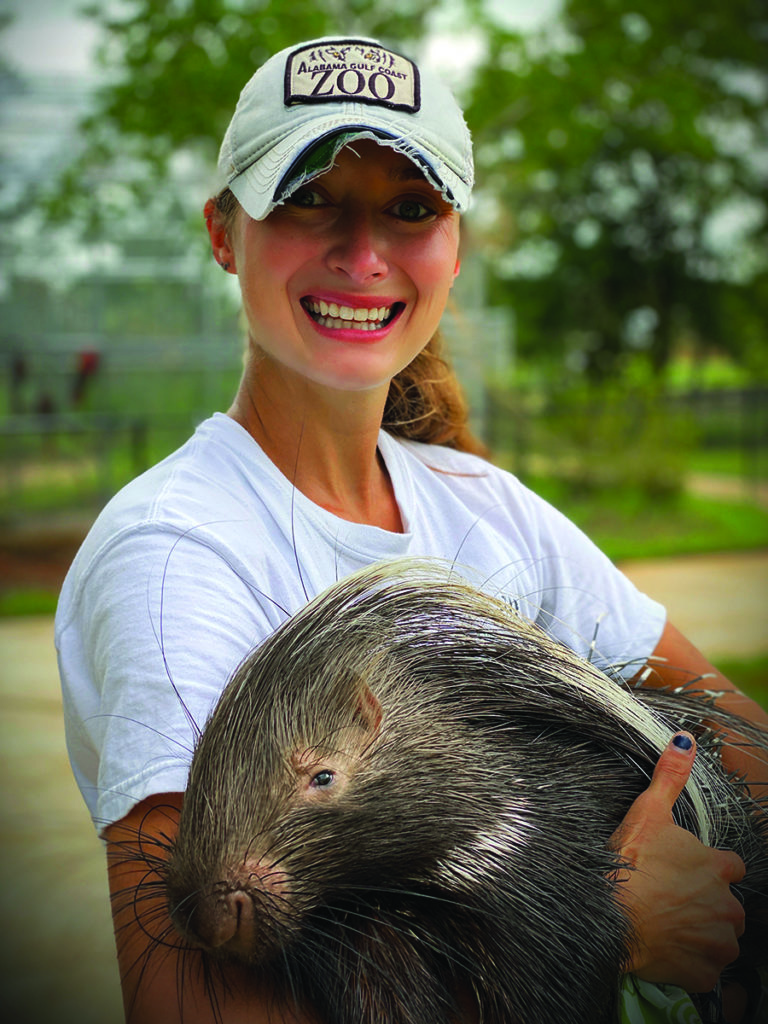by Emmett Burnett

Katrina is due for an annual medical checkup requiring a blood sample. As she receives the shot, her demeanor is calm, which is good – because Katrina is a black leopard.
She backs up to the side of her enclosure. Through the fence, the jungle feline offers her tail, allowing healthcare providers to draw blood from it in a syringe. Yet another story of many at Gulf Shores’ Alabama Gulf Coast Zoo.
“The Little Zoo that Could,” so named by Animal Planet, which produced a 2006 TV series chronicling the facility’s recovery from three brutal hurricanes, is a story in itself. Like some of its occupants, the zoo was once an endangered species.
“We may be the only place in the world to evacuate an entire zoo, three times,” says executive director, Joel M. Hamilton. During hurricanes and the aftermath, animals took refuge in area backyards, fields, and employees’ homes. “Hurricane Ivan (Sept. 16, 2004) was the game changer,” the zoo’s director adds. “It was time to move.”
The zoo, which began in 1989, moved inland six miles in 2018 for a bigger, better facility, with more animals, extra features, and better protection against storms. The grand opening was March 11, 2020.
It closed March 18, 2020.

“It was a fantastic day, lots of excitement!” recalls Hamilton about the zoo’s new beginning that lasted just seven days before it was shut down by COVID-19.
Down but not out, the Alabama Gulf Coast Zoo reopened again on May 23, 2020. With about 25 acres and more coming, over 199 species, 31 sub-species, and 8 endangered species, the Little Zoo that Could is the Little Zoo that Grew.
“It’s still one big loop, but bigger,” says the site’s public relations social media manager Marcale Sisk, as we stroll the boardwalk on a park tour. “Over there is Boodah,” she says, pointing at a massive American black bear, bigger and stronger than you are. “He is 18 years old. When we got him he was no bigger than a football.”
Like most employees here, Marcale refers to the animals by name. In addition to Boodah and previously mentioned Katrina, we greet a wolf trio, Jake, Luna and Jet; one of the giraffe couple, Benjamin; a Eurasian lynx dubbed Casanova; and a pig named – wait for it – Kevin Bacon.
“The exhibits have a closeness feel. It is an intimate experience,” Hamilton adds, while petting a giraffe’s head. “Our staff uses the same public pathways visitors use. We want workers accessible to guests and their questions.”
Behind the scenes
Working at a zoo looks fun, and it is, but at a price. “Running a zoo is a business and an expensive one,” the director says, about custody of creatures on a $5.3 million budget. “We spend $5,000 a week just on animal care and welfare.”
The support staff and behind the scenes work is enormous. Departments here, typical of any other business, include accounting, marketing, social media, food services, a retail gift shop, and relatively new top-notch restaurant. “We are also in the hospitality business,” Hamilton says, “and have a great town for it.”
He says that Gulf Shores is becoming an all-in-one destination. People come for great beaches but while here, they look for other things to do. “We are one of those places.”
In 2021, 234,000 guests walked through the zoo’s gates. “Considering the uncertainty of COVID during that time, that was a good year,” Hamilton says. “We are looking for better numbers in 2022.”
The zoo’s development director, Paula White, agrees. “A lot of people do not realize we are a non-profit. I am thankful for the generosity of people. We could not build this without them and their generous contributions. We depend on visitors coming through the gates, donations, and the kindness of guests.”
Like many of the zoo’s inhabitants, much of the staff is nocturnal. Security personnel patrol the grounds, checking on animals, and making sure all is well, 24/7.
Around 7 a.m., other staffers make their first rounds. With experience, zookeepers learn personalities. Just as no two humans are exactly alike, so are no two animals. “They recognize their people,” Hamilton says. “Baboons call for their keepers as soon as the humans are in sight. Many of our animals distinguish the difference between an employee’s uniform and the guests’ clothes.”
Two kitchens prepare animal meals. For the big cats, the menu is meat, lots of it. A tiger can eat 6 to 8 pounds of chicken and red meat a day. Other inhabitants do not consume as much but require specialized care. It varies by species.
“Some visitors think our reptiles do not take a lot of upkeep because reptiles can go days without eating a bite,” Hamilton says. “But environment maintenance is critical. Most reptiles here bask under ultraviolet light in a room with a constant 78 to 80 degrees.” Deviation beyond those temperatures may result in the animal’s death.
To ensure those needs are met and to discuss other issues, the morning staff meets daily. Animal concerns, maintenance, construction, events scheduled, and other topics are reviewed. “Our people are trained to know their animals,” Hamilton continues. “Any abnormalities are reported at meetings, and to our veterinarians who immediately take action.”
Caring for all kinds of animals
Which brings us back to Katrina the black leopard, a gift from Jack Hanna, TV host of “Jack Hanna’s Animals Adventures.” Why would a wild animal willingly submit to a shot?
“We train our large cats to work with us,” Hamilton says. “Initially they are nervous about being stuck by a needle. But like humans, they get used to it.
“We learn to offer our shoulder for a shot. Cats learn to offer their tails. It makes diagnostics easier on humans and felines and is safer than knocking a big cat down with anesthesia.”

Cleaning animal environments is daily, sometimes hourly, depending on the species. Obviously one does not walk into a lion’s den and announce, “housekeeping!” Cleaning the homes of aggressive animals, such as giant cats with giant fangs, is done by luring the animal into a side room adjacent to their enclosures. For many, these side rooms also serve as their hurricane shelters.
How do zoos obtain animals? Online, sort of. Hamilton says, “We are in a network of zoos and constantly see what is out there. If we want a particular species, we inquire, and sometimes trade an animal we have for one another zoo has.” Most animals in zoos today are raised in captivity, not caught from the wild.
Gulf Shores’ zoo occasionally accepts donations from people who thought they could raise exotic animals as pets. They can’t. The number one donated animal at the Alabama Gulf Coast Zoo? Parrots.
With a day done, some animals bed for the night. Others are just getting started. For employees it is another day of what many animal lovers consider a dream job.
“There’s never a dull moment here,” Sisk says with a smile from her administrative office. Reflecting on working at a zoo, she adds, “A great thing about this job is when having a bad day, I can walk out here and talk to a lemur or sloth and life is good again.”
Zoo employee Paula White has lived in Gulf Shores since childhood. She remembers the zoo’s early days. “It is rewarding to see the zoo come full circle, to see it develop, to be enjoyed by future generations,” she says. “It is nice to see the legacy continue.”
Meanwhile, Katrina the black leopard’s check-up was fine. She’s good to go, just like the Little Zoo that Could, and did.n
The Alabama Gulf Coast Zoo is located on 20499 Oak Road East, Gulf Shores. More information is available at alabamagulfcoastzoo.com.





